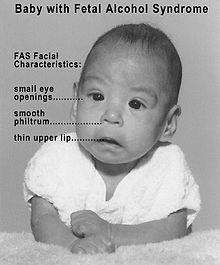
Facial abnormalities not present in most cases.
Back in 1967, when a French pediatrician tried to alert doctors to developmental problems he had recognized in the children of alcohol mothers, he didn’t make much progress. A few years later, pediatrician David Smith began seeing the same sorts of trouble as Paul Lemoine had seen in France. Hoping to draw more attention to the problem, Dr. Smith coined the term fetal alcohol syndrome, or FAS. It was a successful gambit. By now, almost everyone has heard of the disorder. And once NIAAA-funded studies had succeeded in proving that the problem did not only affect the children of poor alcoholic women, research on it has been a major theme at the National Institute on Alcohol Abuse and Alcoholism (NIAAA) ever since. Fetal alcohol disorders may in fact be the most common and preventable form of developmental disorder in the world.
Typically, physicians have used three basic features to diagnose full FAS:
--Characteristic facial abnormalities
--Growth deficits
--Nervous system dysfunctions
But there’s a problem: Fetal Alcohol Syndrome is considered a spectrum disorder, meaning that it includes variations on the full pattern of birth defects. Fetal Alcohol Spectrum Disorder (FASD) doesn’t always show all three of these diagnostic features. In the early going, therefore, clinicians missed a lot of children suffering from FASD, catching only full FAS in the diagnostic net. Kenneth Warren, acting director of the NIAAA, said in a press release that “if you didn’t have the distinctive facial features, you weren’t diagnosed with FAS. If you didn’t have a growth deficit, you weren’t diagnosed with FAS.”
All of this means that recognizing the effects of fetal alcohol exposure is trickier than first thought. For example, FASD is often mistaken for attention deficit hyperactivity disorder (ADHD). The distinction certainly matters, because stimulant medications, which work for some kids with ADHD, are of no use to children with fetal alcohol spectrum disorder. Now, a long-term study of heavy drinking during pregnancy by researchers at the University of Chile appears to nail down the fact that most children regularly exposed to alcohol in the womb do not show the distinct facial characteristics of fetal alcohol syndrome (FAS). Rather, said collaborators on the study at the U.S. National Institute of Child Health and Human Development (NICHD), abnormalities of the nervous system and behavioral problems like language delays, hyperactivity, and attention deficits are far more reliable diagnostic clues.
In the study, investigators interviewed a group of 9000 women in Santiago, Chile, and eventually matched 101 pregnant women who drank four or more drinks a day with a control group of pregnant non-drinkers. The study followed the children until the age of 8. The investigators found “functional neurologic impairment” in 44 % of children whose mothers consumed four or more drinks per day. In contrast, only 17 % of the alcohol-exposed children showed any abnormal facial features.
“Our concern is that in the absence of the distinctive facial features,” said Devon Keuhn of the NICHD in a prepared statement, “health care providers evaluating children with any of these functional neurological impairments might miss their history of fetal alcohol exposure.”
The NICHD University of Chile Alcohol in Pregnancy Study is an ongoing project.
Photo Credit: http://en.wikipedia.org

